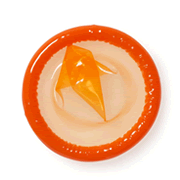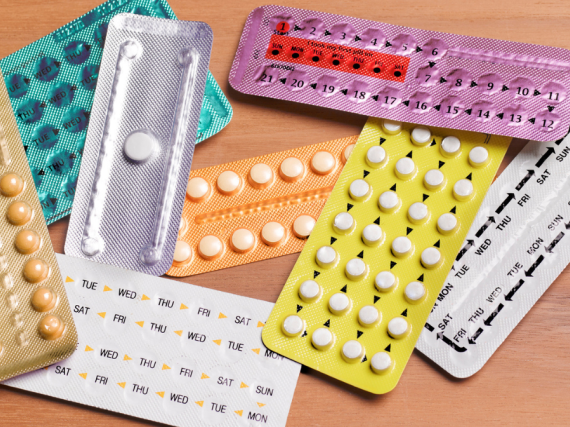Once you get the hang of it, condoms are pretty easy to use, but it can take some practice to get there. And even experienced users make mistakes, so it’s good to refresh your memory on the correct way to use them once in a while.
The most important thing to remember is that if you’re relying on condoms for pregnancy and/or STI prevention, you have to use them every single time you have sex.
_How to put a condom on:_
1. Before you use a condom, check the expiration date. Just like medications or food, condoms can go bad. And condoms that are past their expiration date are more likely to break, which makes them ineffective.
2. When the penis is fully erect (hard), open the condom. It’s easy to tear it if you use your teeth to open it, so use your fingers. Feel for where the condom is inside the wrapper and carefully tear the wrapper so that you don’t damage the condom itself. When you open the wrapper, if the condom inside is torn, or if it feels brittle or stiff, toss it and use a new one. Just like with the things in the back of your refrigerator, a good rule to follow is: when in doubt, throw it out.
3. Check to see if the condom is right side out. It will look like a flat circle with the tip of the condom sticking up. The rolled up part of the condom should be on the outside so that you can easily unroll it as you put it on the penis. If the rolled up part is on the inside, you won’t be able to roll it down the penis easily. If you ever realize that you put on a condom inside out, take it off and put on a new one.
4. Put a drop or two of lube (but not more than that) inside the condom. It’ll help the condom slide on, it will reduce the likelihood of the condom breaking, and it’ll make things more pleasurable for the person with a penis.
5. Pinch the air out of the tip. Hold it. This leaves space at the tip of the condom for the semen to collect when the person wearing the condom ejaculates (cums).
6. Still holding the tip of the condom with one hand, place the rolled-up condom over the tip of the penis. (If the penis is uncircumcised, pull back the foreskin before rolling on the condom.) With the other hand, unroll the condom over the penis as you slide your hand towards the base of the penis, as far as it will go. Condoms do NOT go over the testicles.
7. Check the fit of the condom. It should fit sort of like skin-tight but comfortable leggings. If the penis is fully erect but the condom is loose, or if there’s a lot of rolled-up condom at the base of the penis, the condom is probably too big, making it more likely to come off during sex. If the condom has been fully unrolled onto the penis but there isn’t enough material to cover the whole penis, or if the rolled-up end is cutting off blood flow at the base of the penis, the condom is too small, making it more likely to break during sex.
8. Smooth out any air bubbles that you can see trapped between the penis and the condom—they can cause condoms to break.
9. Add lube to the outside of the condom if you want, to make putting the penis inside the vagina more comfortable for the person with the vagina. Using lube on the outside of the condom can also reduce the chances of the condom breaking.
_How to take a condom off:_
1. After ejaculating, make sure to pull the penis out of the vagina before the penis becomes soft.
2. Hold on to the base of the condom (the part closest to the belly) while pulling the penis out of the vagina. This will help make sure that semen doesn’t spill out of the condom.
3. Once the penis is outside the vagina and away from the vulva, take off the condom. It may be messy so it’s a good idea to have something to clean up with nearby when you take it off.
4. Tie the condom in a knot so the semen can't spill out, then throw it away in a trash can (preferably one that is out of the reach of children and pets). Condoms are not flushable.
5. Make sure the partner with a penis washes their penis with soap and water if it’s going to come into contact with the vulva again.
_Some tips for using condoms:_
1. Always put a condom on before the penis ever touches the vulva. (The vulva is all the sexual parts that are on the outside of the body, including the clitoris and the inner and outer labia. The vagina is on the inside—you can’t see it. It’s the stretchy tube that connects the uterus to the outside of the body.) Pre-cum—the fluid that sometimes leaks from a penis before ejaculation—can contain sperm from the last ejaculation. Putting the condom on before the penis touches the vulva (or anus or mouth) also helps prevent STIs that are spread by skin-to-skin contact.
2. Don’t use two condoms at once (sometimes called double bagging). You might think using two condoms would double your protection, but it doesn’t---in fact, it makes it more likely that both condoms will break, making them ineffective.
3. Don’t use an internal condom and an external condom at the same time. Just pick one every time you have sex.
4. Use one condom per erection. If you put a condom on when the penis is hard, and then it becomes soft with that condom still on, the condom may no longer fit correctly when the penis gets hard again---and fitting well is key to its doing its job.
5. Use one condom per ejaculation. You will need a brand new condom if you want to keep having penis-in-vagina sex after the person with a penis ejaculates. Never rinse out a condom and reuse it---this can make it not work as well.
6. Put on a new condom if you switch between types of sex, even if you haven’t ejaculated. That means that you will need a new condom if you are switching from oral to vaginal sex, anal to oral sex, or anal to vaginal sex, for example.
_Some tips for using condoms made of different materials:_
###Latex Condoms
These are the most commonly used condoms. Make sure not to use them with oil-based lube, which includes massage oil, coconut oil, some lotions, and petroleum jelly. Oil-based lube can cause latex condoms to break. Use water-based or silicone-based lube instead.
###Non-latex Condoms
If you’re allergic to latex, these may be for you. They’re usually made from polyurethane, polyisoprene, or other synthetic materials, and they’re just as good at protecting you from STIs as latex condoms are. Most kinds of non-latex condoms cannot be used safely with oil-based lube because it can cause them to break. So your best bet will be water-based or silicone-based lube.
###Spermicidal Condoms
These condoms are lubricated with a chemical that kills sperm. Even though spermicide on its own can prevent pregnancy, spermicidal condoms aren’t actually any better than non-spermicidal condoms at preventing pregnancy. And if the spermicide used is nonoxynol-9, keep in mind that it may cause irritation, which increases the risk of getting HIV and other STIs. It can also increase the risk of urinary tract infections.
###Natural membrane condoms
These are sometimes called lambskin condoms. They are the only type of condom that does not prevent STIs. Natural membrane condoms are not as commonly used, but they are one of the condom options that are safe for people with latex allergies. Oil-based lube is okay to use with natural membrane condoms---they’re not broken down by the oils.


